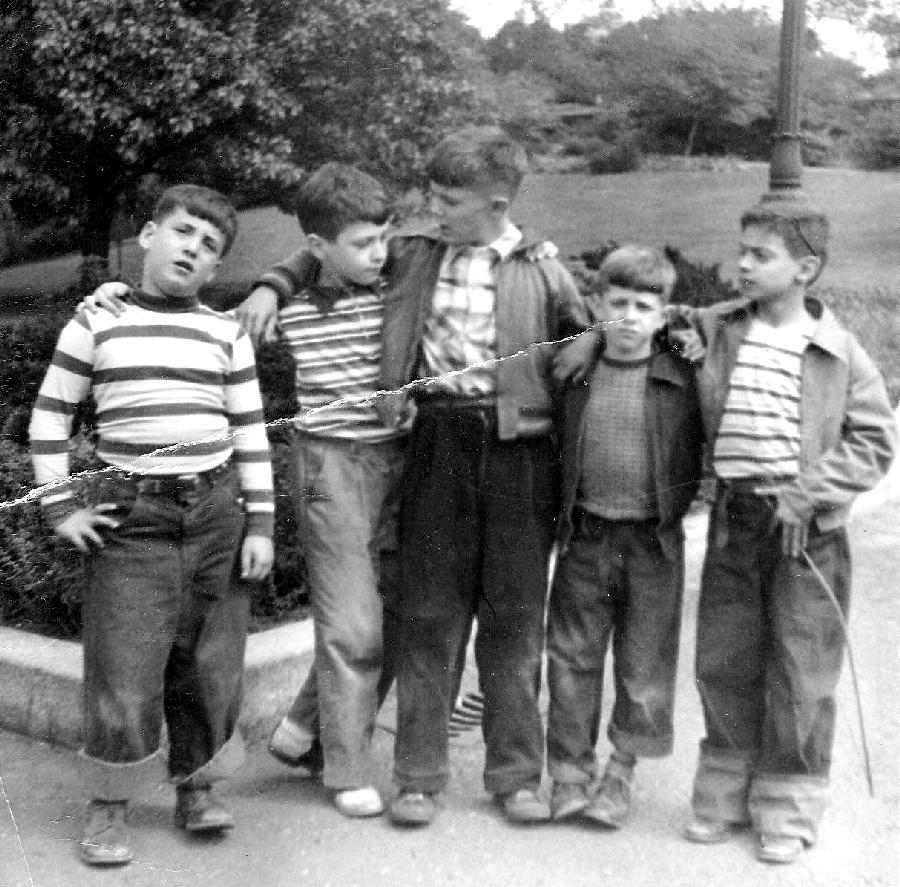
U.S. Boys' Jeans and Overalls: The 1950s

Figure 1.--Here we see five buddies in the 1950s. Notice the cuffed jeans and T-shirts. One boy has a long sleved T-shirt as it was a cool day. T-shirts and jeans were a virtual uniform during the 50s for American boys. Boys might wear jeans to elemenarry (primary) schools, but they were not allowed at most high schools. Notice that the boys are wearing mostly leather shoes not sneakers.
|
|
Experiences varied in the United States. Many American boys literally grew up in jeans and wore them to elementary (primary) school. Boys often wore them in the heat of the summer thinking that short pants were for pre-school boys. I recall when getting a new pair of jeans. For some reason they were like a stiff board. You had to force your feet into the legs to force them open when you first tried them on. I virtually lived in jeans during the summer. Most of my friends did so as well. These were the jeans without the flannel lining. And we cuffed our jeans. This was necessary because moms always brought a little larger size that we could grow into. Other boys especially in the South might wear shorts rather than jeans. One HBC reader reports, "The photo looks like it is right out of the movie 'Stand by Me'. While Beaver and Timmy may have worn jeans to school, that was not the case in Philly where they were not considered proper. [Note: I am not sure Beaver wore jeans to school. I will have to look at the reruns to check that out.] I wore them year round and preferred them to shorts." Another HBC reader writes, "I will tell you that as a youngster I did not care for blue jeans as the kids jeans we wore back then were made of a blend of cotton and nylon and had reinforced knees which made them quite hot and sweaty as well as cumbersome, their durability notwithstanding. I was quite active, particularly during the warm summer months, and preferred to wear light cotton shorts and to go barefooted. Still, my mother would have me wear them and so I did, cuffs turned up and all. Like yourself, too, during winter months, my brother and I wore flannel-lined jeans. [Massengale] The major name brands of kids jeans from the 1950s through the 60s were Billy the Kid "Texans" and Farah of Texas "Gold Strikes." Both brands have, if you will pardon the expression, long since 'faded' into history. Interestingly, both Farah Mfg. Co. and
Hortex, Inc. (Billy the Kid) shared the same home town of El Paso, Texas, hence the emphasis on these brands as being identified as so-called 'Texas jeans' as opposed to 'Western jeans'. (We assume that much of that aspect was due to common knowledge among youth of that era that cowboys came from Texas and not Montana, Idaho or even California. And which kid, growing up in the 50s, didn't want to be a cowboy?) [Massengale] Billy the Kid jeans were featured in 1950s-60s TV shows. Both Jon Provost in 'Lassie' and Johnny Crawford in 'The Rifleman' wore Billy the Kid Blue Jeans. Jon Provost completed the 1950s look with black Keds. Johnny Crawford looks very Western, but jeans like that were not worn in the 1870s-80s, rather overalls with the bib front was the available style.
Sources
Massengale, Marshall. E-mail, October 2, 2002.
HBC

Navigate the Boys' Historical Clothing Web Site:
[Return to Main American 20th century jean page]
[About Us]
[Introduction]
[Activities]
[Biographies]
[Chronology]
[Clothing styles]
[Countries]
[Girls]
[Theatricals]
[Topics]
[Bibliographies]
[Contributions]
[FAQs]
[Glossaries]
[Images]
[Links]
[Registration]
[Tools]
[Boys' Clothing Home]
Navigate the Historic Boys' Clothing Web jean pages:
[Return to the Main U.S. jean page]
[Return to the Main casual page]
[Bibfront overalls]
[Cutoffs]
[Jean shorts]
[Koveralls]
[Baggy jeans]
[Denim]
Navigate the Boys' Historical Clothing Web Site casual pages:
[Return to the Main casual page]
[Camp shorts]
[Clam diggers]
[Cord shorts]
[Jump suits]
[Koveralls]
[Lederhosen]
[Pinafore]
[Shortalls]
[Smocks]
[Soccer shorts]
Navigate the Historic Boys' Clothing Web chronological pages:
[The 1840s]
[The 1870s]
[The 1900s]
[The 1930s]
[The 1940s]
[The 1950s]
[The 1960s]
[The 1970s]
[The 1980s]
[The 1990s]
[The 2000s]
Created: 6:52 AM 3/13/2019
Last updated: 6:16 PM 3/13/2019



